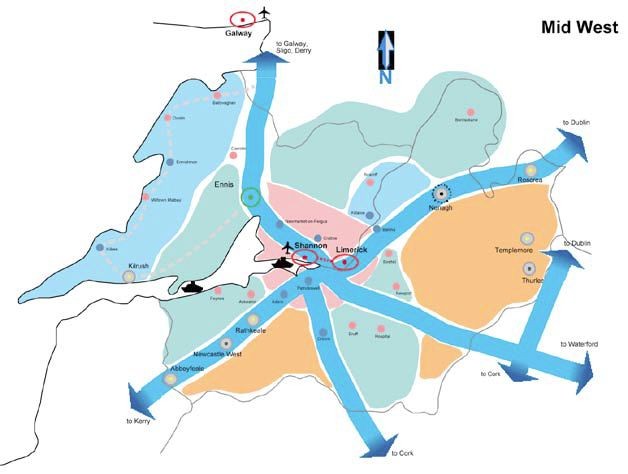The Mid-West Regional Planning Guidelines (RPGs) for systemic regional development
The Mid-West Regional Planning Guidelines (RPGs) are a policy framework by the Mid-West Regional Authority in Ireland, aiming to foster holistic regional development based on sustainability criteria (i.e. environmental, economic and social) criteria. The RPGs include a methodology for evidence-based policy making and consensus on decisions around potentially conflicting issues, such as land use and agriculture, urban infrastructure (water, electricity, etc), transportation routes and so on.

The challenge
The guidelines aim to overcome several challenges for the Irish Mid-West by setting up synergies regarding better interconnectedness of regional centres with a strategic location in Ireland (‘Gateways’), the development of transport corridors and the identification of the role of medium-sized towns and rural areas as drivers of sustainable development.
The measure
Overall, the RPGs take into consideration the following factors in regional planning:
regional and city/county level estimates of population and housing requirements, including a Regional Settlement Strategy (RSS);an assessment of the strength and potential of the region and its constituent city and sub-regional areas (role of medium-sized towns and rural areas);strategic infrastructure investments, e.g. in energy policy, smarter travel and transport, roads and rail systems, broadband communications, higher education and health;new rural enterprise and economic activities including agriculture, manufacturing and service industry (including technology parks), tourism, or renewable energy provision;environmental management: river basin management and flood prevention, water and wastewater treatment and climate change monitoring.The first Regional Planning Guidelines for the Mid-West Region cover the period 2004-2016. The new Guidelines (2010-2022) learn from and build upon these, bringing them up to date and reflecting current and anticipated development trends in the Mid-West Region (they also reflect all other regional and national social, economic and environmental policies which affect the region).
An assessment until today shows that the first RPGs were implemented by all regional planning authorities. 26 different actions were identified that required coordination and collaboration by specifically established standing groups as well as special interest groups. Those groups were supported by a Steering and Monitoring Committee, which, after identifying and agreeing on the areas, from time to time considered progress and any changes in the external environment. However, given the relatively short period of time for the RPGs to have effect, no specific output monitoring tasks were undertaken.
Overall the RPGs are having positive effects on rationalised land use planning, ensuring affordable cost of infrastructures, environmental protection and accessibility to services.
Lessons learnt
At first the guidelines presented real challenges to policy makers and implementation bodies at a local, regional and government level, requiring intense and result-oriented collaboration and networking. During the implementation phase large management and coordination efforts were required for implementing the respective regulations and standards. Also the performance above expectation of some sub-regions, but also the underperformance of others, demonstrated that the region was dealing with complex and difficult processes. It became obvious that tangible outcomes often take longer to attain. The new RPGs can thus be said to have been developed with greater dedication and more creative approaches to achieve the intended socio-economic and environmental outcomes.
Two points were particularly remarkable: the Committees also identified cross-cutting issues which lead to more holistic approaches, and also additional actions were addressed by a variety of ad-hoc structures.
Further deployment
A generic version of the Mid-West Regional Planning Guidelines can easily be transferred to other regions. The approach is estimated to be 8 on the GML scale.
Links
Website